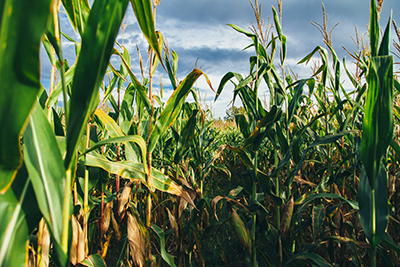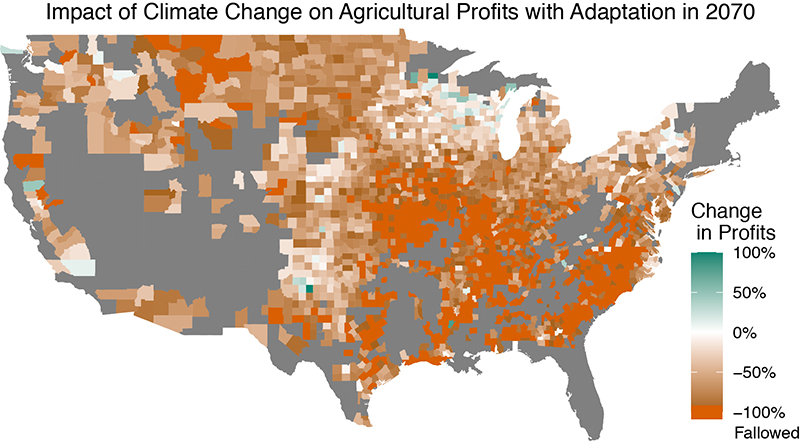Crop relocation can help buffer US agriculture from climate change but southern states may face massive loss of productive land

Crop switching and relocation of crop production to different states could prevent up to half of predicted losses in agricultural profits from climate change impacts according to new research conducted by the Grantham Research Institute on Climate Change and the Environment at the London School of Economics and Political Science published today (October 5th) in Nature Communications.
The research applied a new approach to barley, corn, cotton, soybeans, rice, and wheat crops to estimate the economic potential of crop reallocation in the United States over the next 50 years. It found that if crop locations are held constant in the future, total agriculture profits for the six crops will drop by 31 percent. But if crop lands are reallocated to avoid yield decreases, and take advantage of yield increases, half of these losses are avoided. However, in order to avoid these losses, 57 percent of counties in the United States would be required to plant different crops than they currently do.

Extreme temperatures under climate change are predicted to reduce average yields for several of the United States’ major crops. These changes in productivity will drive farmers to change crops and move into new areas. The extent of these regional changes in agricultural productivity and how they influence future cropping decisions is a central question for the risks of climate change for agriculture and food security.
“Farmers are particularly exposed to the problems of climate change. Adaptation to climate change, for example by investing in irrigation, agricultural research, and new management practices, can take decades of planning,” said James Rising, Assistant Professorial Research Fellow at the Grantham Research Institute on Climate Change and the Environment.
“We need to better understand the potential for adaptation for farmers and policy-makers to make long-term decisions. We show that adaptation through the movement of crops can reduce climate change losses, but it does not eliminate them”.
The research found that the sensitivity of crops to extreme temperatures varies across the United States. Yields for corn and cotton are harmed less by high temperatures in the southern US, reflecting adaptation in seed varieties and farming practices to minimize losses. For wheat and barley, adaptation depends on water availability, with higher sensitivity in dry regions.
When the model was applied to determine the best planting patterns in 2050 and 2070, it found that corn retains its enormous area but becomes less concentrated in the Midwest. Soybeans show a gradual movement north, replacing spring wheat and barley. The wheat lands of the Great Plains see a gradual hollowing-out, while winter wheat moves up from the south along the Mississippi. Cotton, found to be the most resilient crop to rises in temperature, is grown at higher latitudes, becoming the dominant crop in southern California.
At the same time, parts of the southern US become unprofitable for any of the crops studied. These tend to be the hottest counties, and account for 5 percent of currently planted land by 2070. The research did not predict that crops would shift north in an orderly way, because of regional variation in climate and local sensitivity for each of the crops.
“Our results show considerable potential from crop switching to avoid some of the damages from climate change. These opportunities are driven both by differences in how temperatures may change in different regions as well as differences in the sensitivity of crops to higher temperatures. However, the remaining losses imply that crop switching is not a panacea and that new seed varieties and new adaptation practices are needed to support farmers and meet the food demands of the future,” said Naresh Devineni, Associate Professor, Department of Civil Engineering, The City University of New York.
Read the research report “Crop switching reduces agricultural losses from climate change in the United States by half under RCP 8.5”.
– END –
For further information and for interview requests please contact Niamh Brannigan at n.brannigan@lse.ac.uk or call +254 717733348
Notes for editors
About The Grantham Research Institute on Climate Change and the Environment
Established in 2008 at the London School of Economics and Political Science, the Institute brings together international expertise on economics, as well as finance, geography, the environment, international development and political economy to establish a world-leading centre for policy-relevant research, teaching and training in climate change and the environment. It is funded by the Grantham Foundation for the Protection of the Environment. www.lse.ac.uk/grantham/
About The Centre for Climate Change Economics and Policy (CCCEP)
The Centre for Climate Change Economics and Policy (CCCEP) was established in 2008 to advance public and private action on climate change through rigorous, innovative research. The Centre is hosted jointly by the University of Leeds and the London School of Economics and Political Science. It is funded by the UK Economic and Social Research Council. https://www.cccep.ac.uk/
About City University of New York
The City University of New York is the public university system of New York City. It is the largest urban university system in the United States, comprising 25 campuses: eleven senior colleges, seven community colleges, one undergraduate honors college, and seven post-graduate institutions. https://www.cuny.edu/

